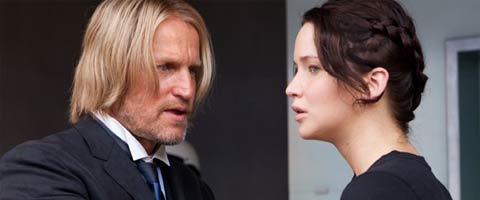The Hunger Games: 5 Things That Worked And 5 That Didn't

For a young adult novel, The Hunger Games is actually a pretty good book. While the genre has been marred by the likes of Stephenie Meyer and the Twilight series, Suzanne Collins’ work is a truly solid piece of dystopian science fiction with interesting comments about today’s world and totalitarian governments. There is a lot to like, from the creative design of the society, the wonderful characters, and the horrors of the Hunger Games arena. But just how well do those various elements play in writer/director Gary Ross’ adaptation?
Thinking back to both their thoughts about the book as well as the film, Eric and Sean have compiled a list five elements that they thought were perfectly translated to the screen and five others that could have been handled better. Read on to see what the filmmakers got right and what they got wrong.
NOTE The very last part in the “WHAT THEY GOT WRONG” section is a bit spoilery, so steer clear if you have not read the books. The rest of the segments, however, are spoiler free.

WHAT THEY GOT RIGHT
The Look and Feel of District 12
Katniss Everdeen springs forth from humble beginnings, and it was very important for Ross to convince us that his beautiful lead could start as a tough but ugly duckling before eventually transitioning into a swan. Lawrence’s experience filming Winter’s Bone no doubt helped her understand Katniss’ broke psyche. But Ross and his production designers helped her immensely by shooting in rural Shelby, North Carolina and employing handheld camera tricks to replicate the poverty and need of the region. It’s a powerful contradiction to the second-act shots in the gaudy Capitol, and it gets The Hunger Games off on the right foot.
The Cornucopia
Your Daily Blend of Entertainment News
A crucial set piece, for so many reasons - which I’ll try not to spoil here - the Cornucopia represents a safe haven for the Tributes, a stash of supplies that can sustain lives in the Games … or be used as bait for a massive trap. There were several different ways that Ross and his team could have envisioned the Cornucopia. He chose a simple, basic, stripped-down design that fit perfectly into the bare-bones arena of the Games. It isn’t an ostentatious prop, primarily because anything larger or more forceful would have been distracting to the action that’s supposed to take place around the set piece. And to reveal much more would be spoiling things.
The Casting of Effie Trinket and Caesar Flickerman
It goes without saying that Lawrence is the perfect choice to play Katniss Everdeen, the self-sufficient archer who voluntarily enters the Games to save her younger sister, Prim. But Ross surrounds Lawrence with immense talent, nailing the casting of several key supporting roles. Though nearly unrecognizable under about 30 pounds of makeup, Elizabeth Banks perfectly embodies not only Effie Trinket, but the spirit and attitude of those who live in the Capitol. And if there could be an Oscar for Bets Scene Stealer, it would belong to Tucci, who embraces the grotesquely detached appreciation Caesar brings to the Games as the celebrity announcer and color commentator. Part friend, part foe, he’s the perfect soundboard for the passive audience, and a welcome guide for the hideous Games.
The Camerawork in the Arena
Media and propaganda are easily two of the most important aspects of The Hunger Games. In fact, the games themselves only exist so that they can be broadcast to the masses and the government can show them just how powerful they are. For that reason the camerawork inside the arena was a essential area for Gary Ross. Fortunately, he succeeded. Constantly shifting angles, moving around the characters and even going as far as to break the 180 degree rule, you get the sense watching the film that the 24 tributes are completely surrounded by cameras capturing every minute of the action.
The Relationship between Katniss and Rue
In the arena you have one clear mission: survive and kill anybody that tries to stop you from surviving. For that reason, relationships in the arena are complicated – but that’s exactly what makes the bond between Katniss and Rue so impressive. In the book we learn that our hero feels a connection to the female tribute from District 11 because she reminds her of Prim. Because you can’t just have Jennifer Lawrence blurt that out, subtly, context, and chemistry has to work and Ross nailed it with Lawrence and Amandla Stenberg.

WHAT THEY GOT WRONG
Haymitch Abernathy
On paper, it sounds perfect. Woody Harrelson’s unforced, Hawaiian hippie act is only two keystrokes away from Haymitch’s reluctant, drunken mentor stance, and the actor who once convincingly played a country rube on Cheers should have been able to pinpoint alcohol-induced indifference (with a thinly-veiled understanding of the larger stakes at the Games). But Harrelson misses it, ever so slightly, and Haymitch is marginalized by a few minor choices the actor makes. They are hard to pinpoint. But Haymitch is written as a scene-stealing savior, the character we’re almost meant to champion more than Katniss (redemption projects always work on broad audiences). I barely remember Harrelson’s Haymitch, and that’s not a good thing.
Katniss and Peeta’s “Fire” Outfits
Another missed opportunity, as something that comes across as triumphant in Collins’ novel looks merely “meh” on screen. Katniss earns the nickname “the girl on fire” because the radiant clothing Cinna (Lenny Kravitz) designs stops Capitol residents in their tracks and drops their jaws. It’s a built-in “Wow,” but Ross’ effect on the flaming suits is more, “That’s it?” It’s hard to fault a book-to-screen adaptation that taps most of its emotional beats, but when Ross whiffs on a not-so-special effect, the Hunger Games really struggles.
Katniss’ Confusion About Peeta’s Feelings
Unless they went the route of voice-over narration (and thank god they didn’t), there was no way that The Hunger Games was going to be able to capture every essence of the book. Because Suzanne Collins’ novel is written in the first person, from Katniss’ perspective, we immediately understand every action and reaction she does and has. While in most areas this worked fine, but one vital territory where it didn’t was in the relationship between Katniss and Peeta. In the book Katniss is constantly questioning Peeta’s behavior, unsure if he’s actually in love with her or just playing politics for the sponsors. It’s lost in translation on the big screen.
Scope Of The Arena
In the book, upon entering the arena Katniss remembers what Haymitch told her: stay away from the Cornucopia, just run and look for water. It’s an important piece of advice, because, as Katniss discovers, water isn’t exactly easy to find. She wanders for a long time and nearly dies of dehydration before finally stumbling upon a pool of precious agua. But in addition to being an early trial for the protagonist to face, the sequence gave readers the sense that the arena is this massive, expansive place. By cutting this long search out of the film, the space in the arena shrinks down and with it goes the scope of the story.
WARNING: DO NOT GO ANY FURTHER IF YOU HAVEN'T READ THE BOOK
The Muttations
This is a bit spoilery, so steer clear if you haven’t seen the film or read the book. But Hunger Games enthusiasts know that the genetically altered wolves that attack Katniss and Peeta near the end of the Games somehow are composed of borrowed DNA from fallen Tributes. It sounds awesome on the page, and was something I was dying to see how Ross handled. Well, he doesn’t. Katniss still fends off gigantic wolves, but they are simple Twilight creatures, without a trace of her vanquished foes. Sure, the effect might have been tough to master, but that’s a missed opportunity.

Sean O’Connell is a journalist and CinemaBlend’s Managing Editor. Having been with the site since 2011, Sean interviewed myriad directors, actors and producers, and created ReelBlend, which he proudly cohosts with Jake Hamilton and Kevin McCarthy. And he's the author of RELEASE THE SNYDER CUT, the Spider-Man history book WITH GREAT POWER, and an upcoming book about Bruce Willis.
